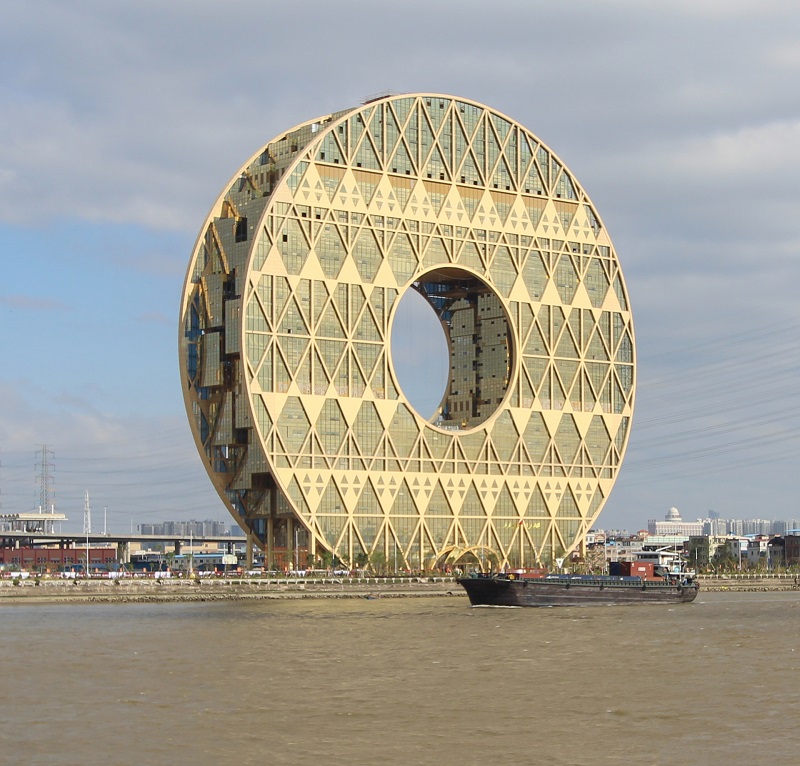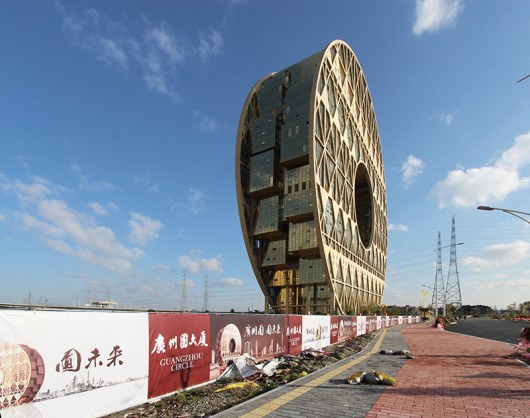Guangzhou Circle
Guangzhou Circle is a landmark building completed in 2013, located on the edge of the Pearl River, Guangdong province, China.
The iconic building was designed by the Italian architect Joseph Di Pasquale as headquarters for Hongda Xingye Group and Guangdong Plastic Exchange. It was intended to serve as a contrast with the stereotypical skyscrapers of the west.
Reaching 138 m, the building has 33 storeys and a total floor area of 85,000 sq. m. It is formed by two rows of blocks that are progressively pushed out to an extreme cantilever of 25 m. This creates a 50 m diameter circular hole in the centre of the building which has almost no architectural comparison anywhere in the world.
The building’s front and rear walls are clad with copper plates, while the curved side walls are formed by a series of glazed rectilinear boxes.
The design concept was inspired by jade discs and the numerological tradition of fengh shui in China. When reflected in the surface of the river, it represents the double disc of jade synonymous with the ancient Chinese dynasty of the area, as well as the number ‘8’, which has a strong resonance in Chinese culture.
[edit] Related articles on Designing Buildings Wiki
- Building of the week series.
- Build operate transfer BOT.
- CCTV Headquarters.
- Fuji TV Building, Tokyo.
- Gate to the East.
- MahaNakhon, Bangkok.
- Manchester Civil Justice Centre.
- Nakagin Capsule Tower.
- Phoenix International Media Center, Beijing.
- Office Center 1000 Kaunas.
- Republic of Kugelmugel.
- Robot Building, Bangkok.
- Teapot building.
- The Atomium.
- Unusual building design of the week.
Featured articles and news
Key points for construction at a glance with industry reactions.
Functionality, visibility and sustainability
The simpler approach to specification.
Architects, architecture, buildings, and inspiration in film
The close ties between makers and the movies, with our long list of suggested viewing.
SELECT three-point plan for action issued to MSPs
Call for Scottish regulation, green skills and recognition of electrotechnical industry as part of a manifesto for Scottish Parliamentary elections.
UCEM becomes the University of the Built Environment
Major milestone in its 106-year history, follows recent merger with London School of Architecture (LSE).
Professional practical experience for Architects in training
The long process to transform the nature of education and professional practical experience in the Architecture profession following recent reports.
A people-first approach to retrofit
Moving away from the destructive paradigm of fabric-first.
International Electrician Day, 10 June 2025
Celebrating the role of electrical engineers from André-Marie Amperè, today and for the future.
New guide for clients launched at Houses of Parliament
'There has never been a more important time for clients to step up and ...ask the right questions'
The impact of recycled slate tiles
Innovation across the decades.
EPC changes for existing buildings
Changes and their context as the new RdSAP methodology comes into use from 15 June.
Skills England publishes Sector skills needs assessments
Priority areas relating to the built environment highlighted and described in brief.
BSRIA HVAC Market Watch - May 2025 Edition
Heat Pump Market Outlook: Policy, Performance & Refrigerant Trends for 2025–2028.
Committing to EDI in construction with CIOB
Built Environment professional bodies deepen commitment to EDI with two new signatories: CIAT and CICES.
Government Grenfell progress report at a glance
Line by line recomendation overview, with links to more details.
An engaging and lively review of his professional life.
Sustainable heating for listed buildings
A problem that needs to be approached intelligently.
50th Golden anniversary ECA Edmundson apprentice award
Deadline for entries has been extended to Friday 27 June, so don't miss out!
CIAT at the London Festival of Architecture
Designing for Everyone: Breaking Barriers in Inclusive Architecture.
Mixed reactions to apprenticeship and skills reform 2025
A 'welcome shift' for some and a 'backwards step' for others.




























